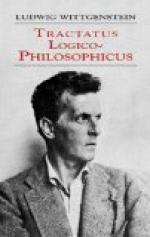2.18 What any picture, of whatever form, must have in common with reality, in order to be able to depict it—correctly or incorrectly—in any way at all, is logical form, i.e. the form of reality.
2.181 A picture whose pictorial form is logical form is called a logical picture.
2.182 Every picture is at the same time a logical one. (On the other hand, not every picture is, for example, a spatial one.)
2.19 Logical pictures can depict the world.
2.2 A picture has logico-pictorial form in common with what it depicts.
2.201 A picture depicts reality by representing a possibility of existence and non-existence of states of affairs.
2.202 A picture contains the possibility of the situation that it represents.
2.203 A picture agrees with reality or fails to agree; it is correct or incorrect, true or false.
2.22 What a picture represents it represents independently of its truth or falsity, by means of its pictorial form.
2.221 What a picture represents is its sense.
2.222 The agreement or disagreement or its sense with reality constitutes its truth or falsity.
2.223 In order to tell whether a picture is true or false we must compare it with reality.
2.224 It is impossible to tell from the picture alone whether it is true or false.
2.225 There are no pictures that are true a priori.
3 A logical picture of facts is a thought.
3.001 ‘A state of affairs is thinkable’: what this means is that we can picture it to ourselves.
3.01 The totality of true thoughts is a picture of the world.
3.02 A thought contains the possibility of the situation of which it is the thought. What is thinkable is possible too.
3.03 Thought can never be of anything illogical, since, if it were, we should have to think illogically.
3.031 It used to be said that God could create anything except what would be contrary to the laws of logic.The truth is that we could not say what an ‘illogical’ world would look like.
3.032 It is as impossible to represent in language anything that ‘contradicts logic’ as it is in geometry to represent by its coordinates a figure that contradicts the laws of space, or to give the coordinates of a point that does not exist.
3.0321 Though a state of affairs that would contravene the laws of physics can be represented by us spatially, one that would contravene the laws of geometry cannot.
3.04 It a thought were correct a priori, it would be a thought whose possibility ensured its truth.
3.05 A priori knowledge that a thought was true would be possible only it its truth were recognizable from the thought itself (without anything a to compare it with).
3.1 In a proposition a thought finds an expression that can be perceived by the senses.
3.11 We use the perceptible sign of a proposition (spoken or written, etc.) as a projection of a possible situation. The method of projection is to think of the sense of the proposition.




